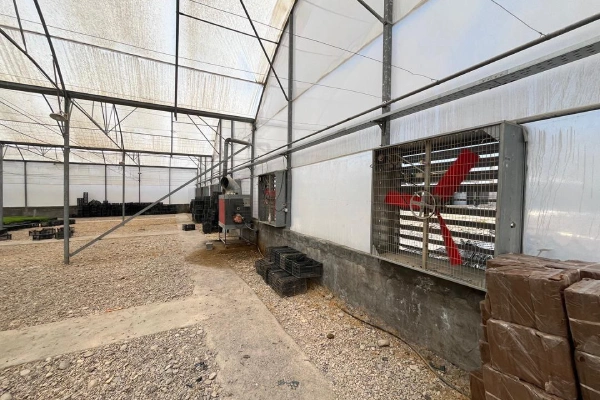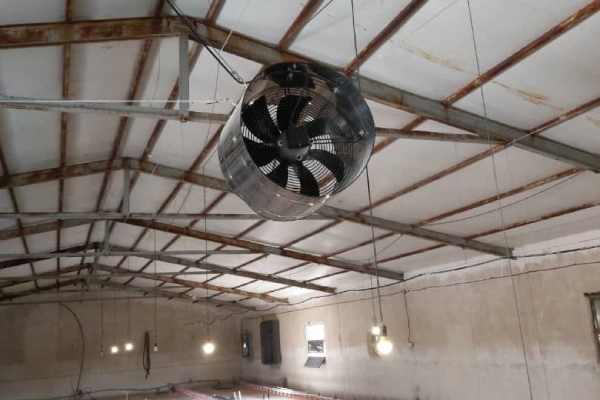Fan power calculation formula table + how to calculate it

Have you ever come across the term CFM when choosing a fan for your home or office? What is cfm? This abbreviation stands for Cubic Feet per Minute and refers to the amount of air a fan moves per minute. This unit of measurement plays a very important role in choosing the right fan for a space.
But fan CFM is a little different from general CFM. In this article, we are going to take a closer look at these differences and answer questions such as “How is CFM calculated?” and “What factors affect the CFM of an orbital fan?” Join us as we learn the key concepts in calculating and selecting a fan. By reading this article, you will be able to easily choose the fan you need and ensure the optimal performance of your ventilation system.
Table of contents
- Calculating the CFM Required for Fan Selection
- Calculating the CFM of a Fan: The Key to Selecting the Right Fan
- Factors Affecting the Volumetric Flow Rate of a Fan
- Alvand Industrial Group: A Leader in the Ventilation and Heating Industry
Calculating CFM Required for Fan Selection
To select a fan with proper efficiency, it is important to accurately calculate the required air volume, or CFM. CFM stands for Cubic Feet per Minute and indicates the volume of air that passes through a system per minute. In this section, we will explain how to calculate fan power step by step and with practical examples.

Step 1: Determine the area and volume of the space
Precise measurement: Using a meter, accurately measure the length and width of the desired space.
Calculate the area: Obtain the area by multiplying the length by the width.
Calculate the volume: Multiply the useful height of the space by the obtained area to obtain the volume of the space in cubic meters.
Example: Suppose we want to calculate the CFM required for a room with a length of 5 meters, a width of 4 meters, and a height of 3 meters.
Area = length × width = 5 meters × 4 meters = 20 square meters
Volume = area × height = 20 square meters × 3 meters = 60 cubic meters
Step 2: Determine the number of air changes
Standards: The number of air changes per hour varies depending on the type of use of the space. There are specific standards for different spaces such as homes, offices, and factories.
Standards table: Use the standard tables available in reliable sources or building codes to find the appropriate number of air changes for your space.
You can extract these numbers from the table below according to the type of location:

Step 3: Calculate the required air volume
Calculation formula: Required air volume per hour = Space volume × Number of air changes per hour
Unit conversion: Convert the result obtained from cubic meters per hour to cubic feet per minute CFM. To do this, multiply the product by 0.589.
For example, suppose that for a living room in a residential building, the standard number of air changes per hour is set at 5 times.
Required air volume per hour: 60 cubic meters × 5 times = 300 cubic meters/hour
Required air volume in CFM is equal to: 300 cubic meters/hour × 0.589 = 176.7 CFM
By following the above steps and considering the effective factors, you can calculate the required CFM for your space and choose the right fan. Choosing the right fan helps improve ambient air quality, reduce energy consumption, and increase the comfort of residents.
Calculating Fan CFM: The Key to Choosing the Right Fan
As we mentioned, CFM (Cubic Feet per Minute) indicates the volume of air that a fan moves per minute. To accurately calculate the CFM of a fan, the formula for calculating fan power is used:

CFM = Air inlet cross-sectional area (square feet) × Air velocity (feet per minute)
Formula components:
Air inlet cross-sectional area: This area is circular and is calculated using the formula for the area of a circle (πr²). In this formula, r is the radius of the circle (the radius of the fan inlet).
Air velocity: This speed can be measured using a device called an anemometer. An anemometer shows the speed of air flow in meters per second or feet per second.
If you are looking for proper guidance on setting up your greenhouse, we introduce you to the article on greenhouse equipment requirements.
Convert Units
CFM to Cubic Meters per Hour (m³/h): To convert CFM to m³/h, multiply CFM by 1.7.
Cubic Meters per Hour (m³/h) to CFM: To convert m³/h to CFM, multiply m³/h by 0.5886.
Practical Examples
For the first example, suppose we have a greenhouse circulation fan with a 1-foot diameter opening and we have measured the air velocity to be 1000 ft/min. Calculate the CFM of this fan.
Radius of a circle 0.5 = (r) ft
Cross-sectional area = π × (0.5)² ≈ 0.785 sq ft
CFM = 0.785 sq ft × 1000 ft/min = 785 CFM
For the second example, suppose we have a fan with a volumetric flow rate of 1000 m³/h. Convert this value to CFM.
CFM = 1000 cubic meters per hour × 0.5886 ≈ 588.6 CFM
Important points in this regard:
Accuracy in measurement: Accuracy in measuring the diameter of the fan opening and the air velocity is very important for accurate calculations.
Choosing the right unit: The units used in the calculations must be the same. If the diameter of the fan opening is in centimeters, you must convert it to feet.
Pay attention to static pressure: In addition to CFM, the static pressure of the fan also plays a role in choosing the right fan. Static pressure indicates the ability of the fan to overcome the resistance of the ducting system.
If you are curious about how to choose an exhaust fan and what factors we should pay attention to, you can go to the article in question.
Factors affecting fan volumetric flow rate
The fan’s volumetric flow rate, which indicates the volume of air that the fan moves per unit of time, is affected by various factors. Below, we will examine some of the most important of these factors:
1. Effect of fan speed on volumetric flow rate
The speed of rotation of the fan impeller has a direct relationship with volumetric flow rate. In general, as the impeller speed increases, the amount of air that the fan moves also increases. This is because as the speed increases, more energy is transferred to the air and, as a result, the air exits the fan at a faster speed.
2. Effect of wind on volumetric flow rate
Wind can have a significant effect on fan performance. Both the direction of the wind and its speed affect the volumetric flow rate.
Wind direction: If the wind direction is aligned with the direction of the air flow exiting the fan, it increases the volumetric flow rate. However, if the wind direction is opposite to the direction of the exhaust air flow, it will reduce the volumetric flow rate.
Wind speed: Increasing wind speed can increase or decrease the volumetric flow rate. This depends on the wind direction and the fan design.
3. The effect of altitude on volumetric flow rate
Air density decreases with increasing altitude. This decrease in density causes a fan to move a larger volume of air at higher altitudes to move the same amount of air mass. In other words, to move a given amount of air mass at higher altitudes, the fan must operate at a higher speed or use a larger diameter impeller.
Conclusion
In this article, you learned what cfm is. Accurately calculating CFM is the key to selecting the right fan. If CFM is not calculated correctly, the fan may be either too strong or too weak, both of which will damage the ventilation system. To ensure the accuracy of the calculations, use accurate measuring instruments and refer to relevant standards. Also, consider environmental factors such as temperature, humidity, and altitude. By choosing the right fan, you can achieve optimal ventilation system performance and increase the useful life of the equipment.
Alvand Industrial Group: A Leader in the Heating and Ventilation Industry
Are you looking for high-quality heating and ventilation equipment for your business? Alvand Industrial Group products will meet your needs, because Alvand Industrial Group, with years of experience, is one of the pioneers in the production of industrial heating and ventilation equipment in the country. For more information and free consultation, contact the experts of this group.




 2025-01-11
2025-01-11 30 minute
30 minute
 0 comment
0 comment
